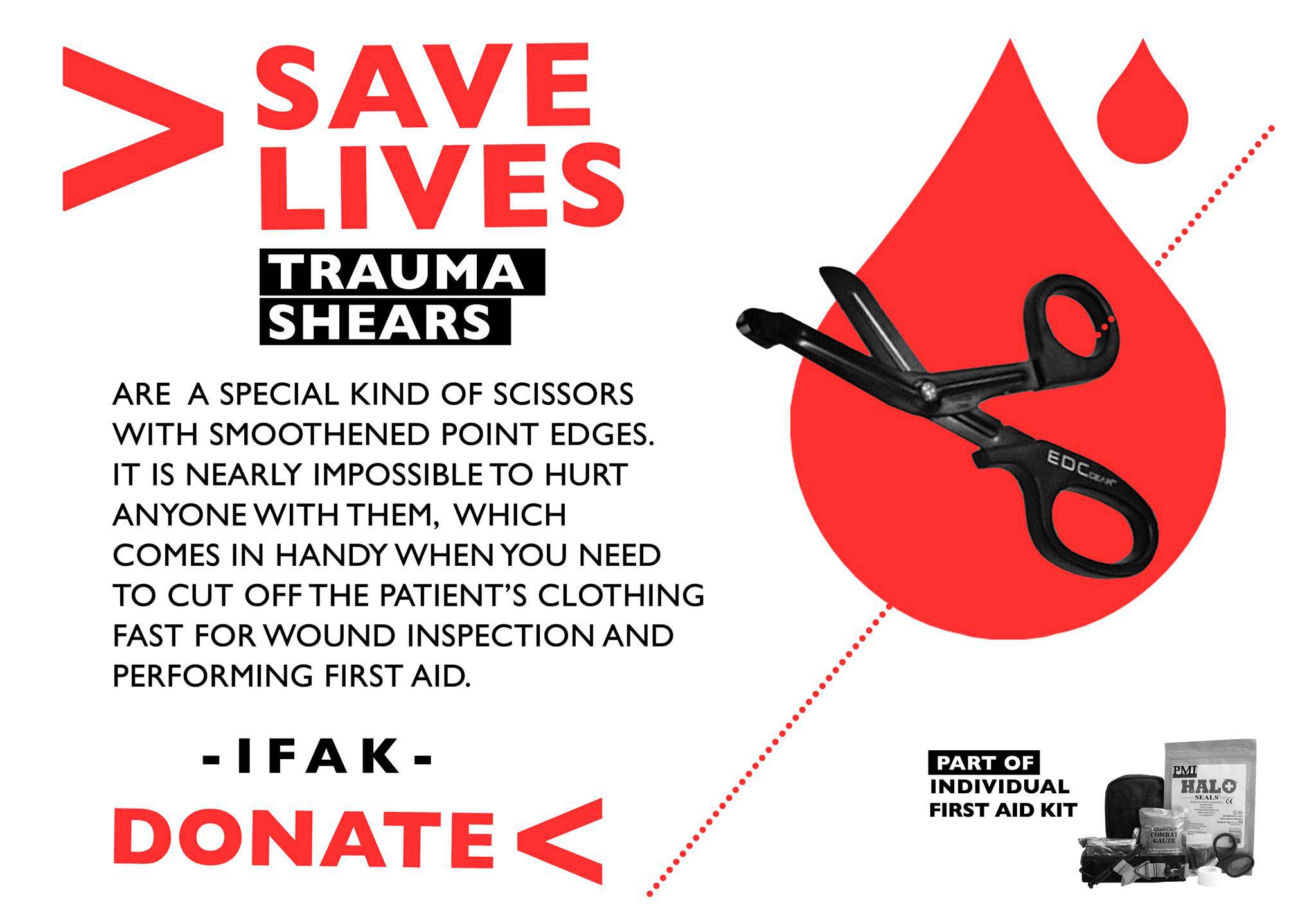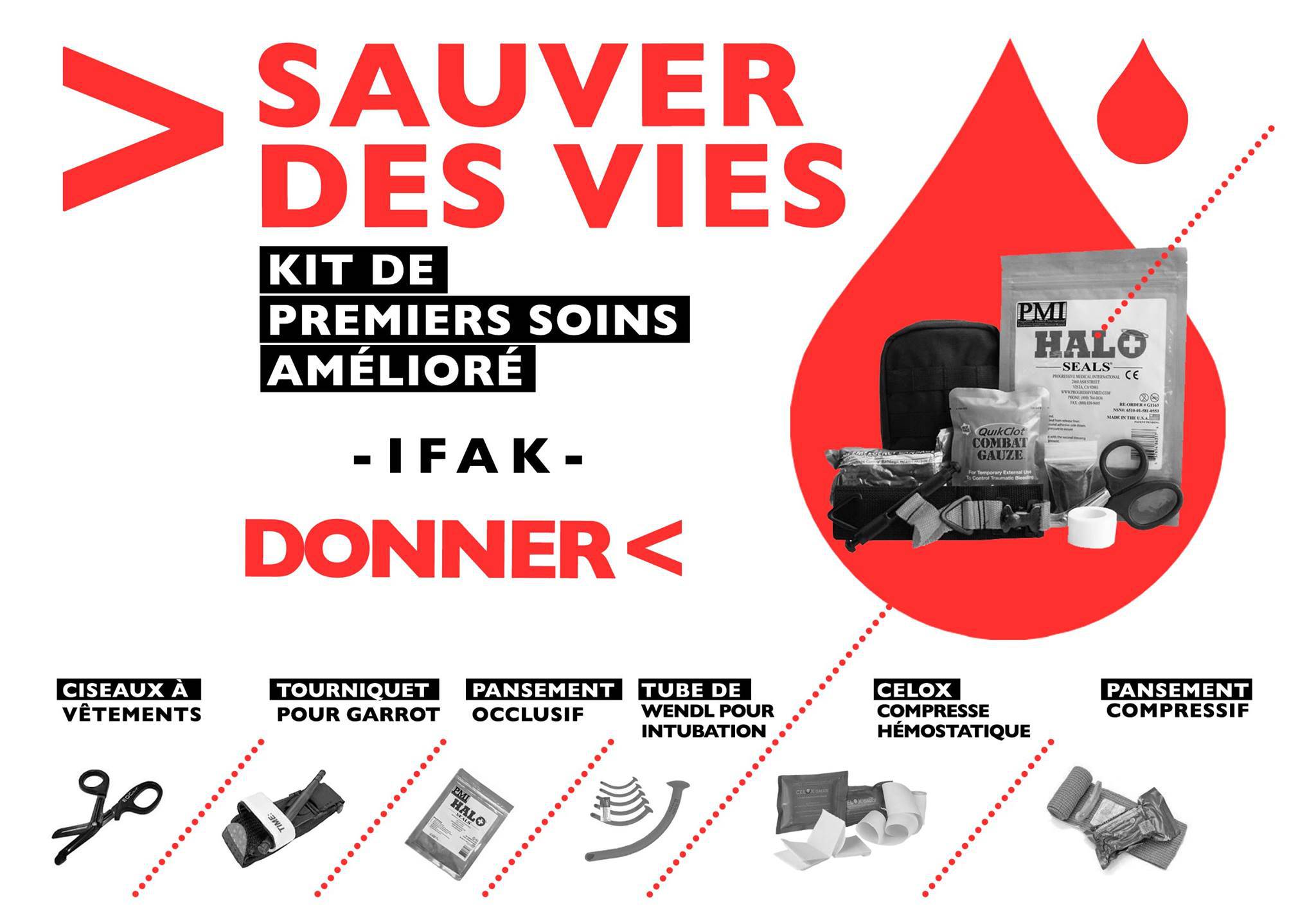EuroArmyMaydan is running a fundraiser for 100 Individual First Aid Kits (IFAKs) for the Ukrainian Army. In order to help them gather funds, Katya Mischenko-Micyk and Tomasz Komorniczak together with EuromaidanPR has created a series of graphics on the components of the IFAK. They can be freely used for non-commercial purposes.
English
1. IFAK
Every third wounded Ukrainian soldier dies. In the USA the survival rate is up to 90%! The reason is good training in combat first aid and a well-equipped Individual First Aid Kit (IFAK) for every soldier.
The IFAK increases individual soldier capabilities to provide Self-Aid/Buddy-Aid and provides interventions for two leading causes of death on the battlefield, severe haemorrhage and obstructed airway. These capabilities increase soldier survival during operations far from medical assistance structures.
2. CAT (Combat application tourniquet)
Blood loss from arterial bleeding is the leading cause of combat mortality, taking up to 85% of combat deaths. A soldier can literally bleed out in 5 minutes if the large artery is opened. Help save these soldiers with Combat Application Tourniquets (CAT)! A CAT can be put on with a single hand and compress the wounded blood vessels in 10-30 seconds, preventing deadly blood loss!
3. Chest Seals to prevent pneumothorax
Pneumothorax is one of the main causes of combat death. It results from gunshot wounds to the chest that compromise the integrity of the pleural cavity. When air enters pleural cavity, it prevents the lungs from expanding and adequately collecting oxygen from the air. It also compresses the heart. This leads to death from hypoxia and cardiac failure. Sets of chest seals help clear out the air from the pleural cavity and close up the bullet holes.
4. Nasopharyngeal airway
Blocked air passages is a prominent reason for combat mortality from hypoxia. To fix this condition, special nasopharyngeal airway tubes are inserted through the nose using medical gel.
5. Trauma shears
Trauma shears are a special kind of scissors with smoothened point edges. It is nearly impossible to hurt anyone with them, which comes in handy when you need to cut off the patient’s clothing FAST for wound inspection and performing first aid.
6. Hemostatic gauze
Blood loss is the leading cause of combat mortality, taking up to 85% of combat deaths. Hemostatic gauze stops the bleedings fast and makes the doctor’s task of dressing, cleaning and stitching up the wound easier! The gauze is soaked in Celox clotting agents and can be securely compressed into the wound to stop the bleeding fast even in extreme weather conditions.
7. Trauma wound compression bandage
Blood loss is the leading cause of combat mortality. Help fight it with the trauma wound compression bandage. This device consists of compression pad, elastic bandage and a latch to keep them securely in place. The compression bandage is used to dress the wound after an arterial bleeding has been stopped with a CAT (combat application tourniquet).
German
Jeder dritte verletzte Ukrainische Soldat stirbt. In den USA. beträgt die Überlebenschance bis zu 90%.
Die Gründe dafür sind: Entsprechende Schulungen in Militärischer Erste Hilfe(Notfallversorgung) und ein gut ausgestatetes Erste Hilfe Paket (Engl. : IFAK) für jeden Soldaten.
Das IFAK(Engl. für Erste Hilfe Paket) erhöht die Fähigkeit einzelner Soldaten zur Selbstbehandlung oder der Behandlung von Kameraden und bietet zudem Gegenmaßnahmen für zwei der am häufigsten auftretenden Todesursachen auf dem Schlachtfeld, schwere Blutungen sowie Atemnot. Dadurch wird die Überlebenswahrscheinlichkeit des Soldaten, während einer Militäroperation ,erhöht.
EuroArmyMaydan hat eine Spendenaktion ins Leben gerufen, um Soldaten, die auf dem Schlachtfeld kämpfen ,100 dieser Erste Hilfe Pakete (Engl. IFAKs) zu kaufen. Es werden noch 7.000 $ benötigt. Helfen Sie bitte mit und spenden Sie!
http://www.youcaring.com/medical-fundraiser/ifaks-for-ukrainian-soldiers/212021
Portugese
Cada terceiro soldado ucraniano ferido morre no campo de batalha por falta de primeiros socorros. Nos EUA, a taxa de sobrevivência é de até 90% e o motivo é um bom treinamento em primeiros socorros de combate e fornecer um Kit individual de primeiros socorros (IFAK) para cada soldado.
O IFAK aumenta a capacidade individual do soldado em fornecer auto-socorro/socorro a companheiros e intervenções para duas causas de morte principais no campo de batalha, hemorragia severa e obstrução das vias aéreas. Esses recursos aumentam a sobrevivência do soldado durante as operações distante de centros de assistência médica.
EuroArmyMaydan está promovendo uma campanha para comprar 100 IFAKs para os soldados no campo de batalha. Ainda é necessário arrecadar USD$ 7.000,00 e você poderia ajudar a aumentar o índice de sobrevivência entre os soldados.
http://www.youcaring.com/medical-fundraiser/ifaks-for-ukrainian-soldiers/212021
French
Un soldat ukrainien blessé sur trois décède. Aux Etats-Unis, 90% survivent. Cela est dû à une bonne instruction portant sur les premiers soins et le fait que chaque soldat possède un kit de premier secours bien étudié. (IFAK)
L’IFAK (kit de premiers soins amélioré) donne la possibilité aux soldats de procéder sur eux mêmes ou sur un camarade aux interventions sur les deux premières causes de décès au combat, les hémorragies sévères ou les difficultés respiratoires.
Ces possibilités augmentent la survie du soldat lors d’opérations éloignées de structures médicales.
EuroArmyMaidan lance une souscription pour acheter 100 IFAK à remetttre aux soldats en opérations. Il leur manque 7000 USD, vous pouvez aider à sauver une vie !
http://www.youcaring.com/medical-fundraiser/ifaks-for-ukrainian-soldiers/212021
[hr]Tomasz Komorniczak is a graphic artist, you can find his work here: www.wzorki.co. Katya Mischenko-Micyk runs the page Euromaidan Arts&Graphics and has done many graphics in support of Ukraine and Euromaidan.










